11 March, 2000
Collecting Marine Invertebrates and Plants
Question 21: What is the largest penguin?
Although this is a Saturday, it is not a day off. We stop outdoor work only
for extremely bad weather, and we won't stop working in the lab and aquarium
tanks until we leave in May. Now, at the beginning of our time here, our
diving is focused on collecting organisms to bring back to the station. Today
we put five divers in the water. Before lunch, Drs. Iken and Amsler dove from
the north side of Gammage Point, the spit of land the station sits on. There
was some tidal surge sloshing broken chunks of ice (brash ice) against the
shore where they went in. Once through the ice, there is no problem diving in
these conditions.
After lunch Andy Mahon, Boating Coordinator Ross Hein, and I did a boat dive
on the far side of Hero Inlet from the station. Shore topography usually
continues down into the water; this is true in this area where the rock shore
drops steeply into the water and continues down to about 50 feet. At 50 ft we
hit a soft silty bottom that sloped a little bit-- the bottom of the channel
in the inlet.
While we have divers in the water, the red and white dive flag is
flown in the area or from our boat. The names and the location of the dive
are posted for everyone to see on the sign-out board, and we radio the
communication center (coms) when divers are down. The concern is to make
sure everyone else on the station knows when and where diving is going on so
they can be careful. Both station staff and other science groups are active
with boating operations (ops), which are our main source of danger from
humans. The non-diving members of our research team act as tenders and help
the divers put on and adjust their gear and enter and exit the water. Once
the divers are in the water and have begun their dive, one or two of the
tenders remain in the area to make sure there are no problems.
Divers take collection bags on the dive with them. They are large enough
to hold even the huge, leafy macroalgae (seaweed) although we are not
collecting it specifically yet. Bags are made of mesh fabric and have a metal
rim that folds in half to hold the bag either open or closed. Right now we
are collecting any invertebrates (I will go into the types present in a later
journal) and a few target species of macroalgae.
Once the diver comes out of the water, a tender takes the bag and rushes it
to the aquarium. Our science group has several large outdoor sea water tanks,
two indoor tanks and two water trays to hold the organisms we are working
with. All are constantly supplied with freshly pumped and filtered sea water.
The organisms are dumped into a tray or tank right away to get them back in
the water. Then we sort them into rough groups of macroalgae, sponges and
other invertebrates. We have also gotten a few fish (vertebrates since they
have a spinal column) along with the macroalgae. Some are quite colorful!
Answer 20: There are 18 species of penguins. All live in the southern
hemisphere. The emperor and the Adelie breed on the continent itself or on
the fast ice anchored to it. Five other species have ranges that include the
subantarctic islands and in some cases the northern part of the Antarctic
peninsula. They are the royal, macaroni, king, gentoo and chinstrap penguins.
The other 11 species live further north.
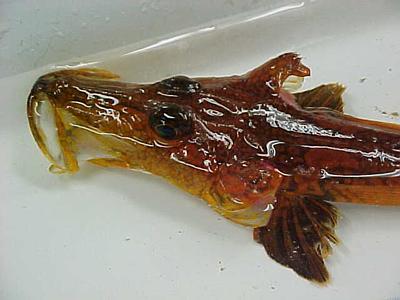
Fish responding to seeing predator (me) with a threat display.
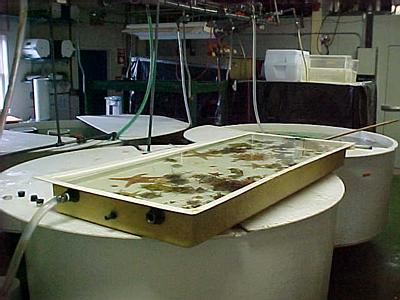
Aquarium room with sea water tanks and trays.

Outdoor sea water tanks behind the Biolab building.
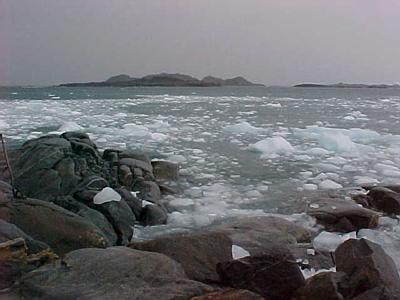
Brash ice off the north side of Gammage Point looking out into Arthur Harbor.
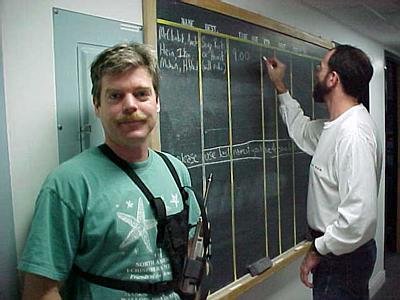
Drs. McClintock (with radio harness) and Amsler signing our dive group out.
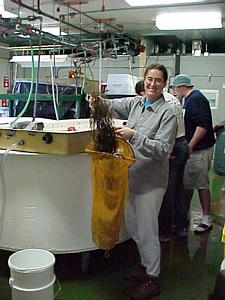
Macroalgae going from collecting bag to seawater tray.
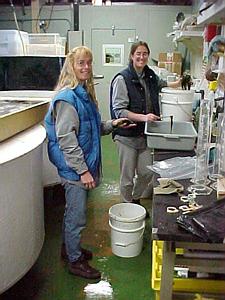
Katrin Iken and Joanna Hubbard cleaning macroalgae.
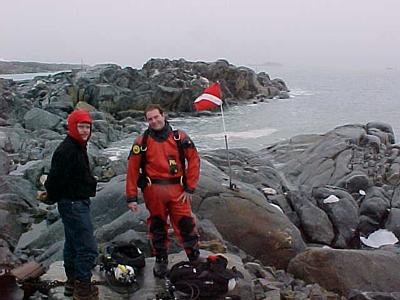
Tender, diver and dive flag on Gammage Point.

Contact the TEA in the field at
.
If you cannot connect through your browser, copy the
TEA's e-mail address in the "To:" line of
your favorite e-mail package.
|
